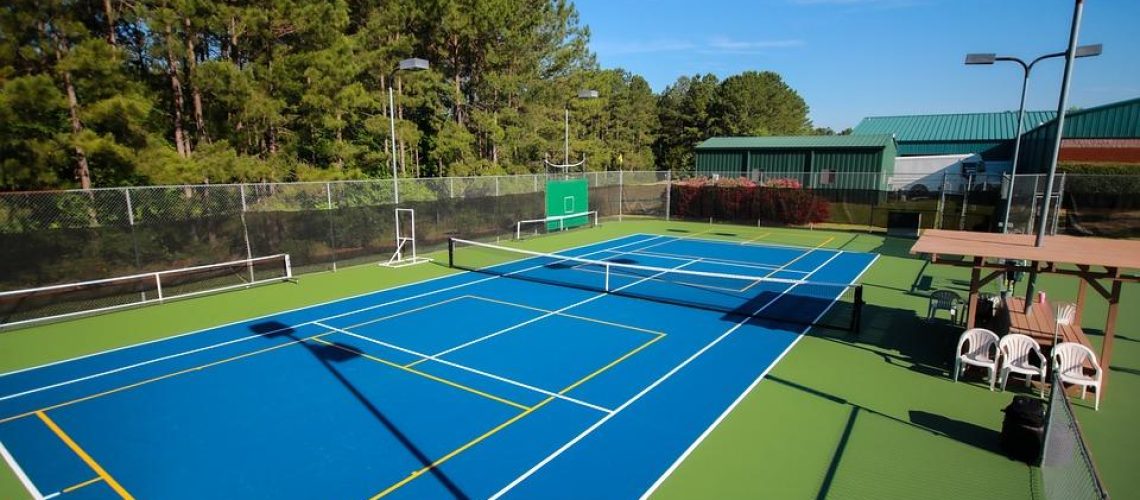We may earn money or products from the companies mentioned in this post.
Brief overview of tennis as a popular sport

Tennis is a widely loved and highly popular sport that attracts millions of players and fans worldwide It is a game that requires precision, agility, strategy, and mental focus Whether you’re playing for fun or aiming to become a professional player, regular practice is essential to improve your skills and enhance your overall performance on the court
1 Importance of regular practice
Practice makes perfect, they say – and it couldn’t be truer for tennis Consistent practice helps players develop muscle memory, reflexes, coordination, and endurance By dedicating time to practicing various aspects of the game, such as serving, volleying, footwork, and shot placement, players can refine their techniques and gain confidence in their abilities
2 Challenges faced by amateur and professional players
Tennis poses unique challenges for both amateur enthusiasts and professional athletes alike Amateurs often struggle with consistency in their shots due to limited experience and lack of proper training On the other hand, professionals face intense competition at higher levels where every point counts
Additionally, external factors like weather conditions can disrupt practice sessions or matches While professionals may have access to state-of-the-art facilities and trainers to help them overcome these challenges, amateurs need alternative methods to continue honing their skills
Purpose of the blog post

This blog post aims to address the need for tennis enthusiasts to practice at home when circumstances prevent them from accessing tennis courts or training facilities regularly
1 Addressing the need to practice at home
In today’s fast-paced world with busy schedules and unpredictable circumstances (such as travel restrictions or inclement weather), finding time to visit a tennis court consistently can be challenging However, this should not hinder a player’s progress
Practicing at home allows players to maintain their connection with the sport, improve their skills, and stay active even when they cannot access professional training facilities or play on an actual court
2 Providing guidance on how to effectively practice tennis at home
This blog post will provide valuable guidance on how tennis enthusiasts can make the most out of practicing at home It will cover various aspects such as setting up a practice area, focusing on specific skills and techniques, utilizing technology and video analysis tools, incorporating fitness routines, and maintaining motivation and discipline in solo practice sessions
By offering practical tips and insights, this blog post aims to empower readers to continue their tennis journey even from the comfort of their own homes
Setting up an ideal space for practicing tennis at home

When it comes to honing your tennis skills, having a dedicated space to practice at home can make a world of difference Whether you’re a beginner or a seasoned player, setting up the right environment is crucial for improving your game Let’s explore some key factors to consider when creating an ideal tennis practice area
Choosing the right location
Before diving into the logistics of setting up your own tennis practice space, it’s important to choose the right location Indoor or outdoor? That’s the first question you need to answer Both options have their pros and cons, so think about what suits your needs and preferences best
If you have ample indoor space available, such as a garage or basement, setting up an indoor practice area can offer several advantages It allows you to play regardless of weather conditions and provides privacy for uninterrupted training sessions
On the other hand, if you prefer the fresh air and open skies, consider utilizing your backyard, garden area, driveway, or patio for an outdoor practice space Just make sure that there is enough room for swings and movement without risking any damage to property or injury
Ensuring safety precautions are in place
Safety should be a top priority when setting up your own tennis practice area Before swinging that racket with full force, take some precautions to avoid accidents or injuries
Ensure there is ample space clearance around your designated playing area Remove any obstacles like furniture or equipment that could hinder your movements during gameplay This will not only prevent accidents but also allow you to fully utilize the available space
The choice of flooring or surface material is another crucial aspect of ensuring safety while practicing tennis at home Opting for non-slip surfaces is highly recommended, as it minimizes the risk of slips and falls Indoor spaces can benefit from rubberized or synthetic flooring, while outdoor areas can utilize materials like artificial turf or interlocking tiles that provide good traction
By taking these safety precautions, you can create a secure environment where you can focus on improving your tennis skills without any worries
Now that we’ve discussed the importance of choosing the right location and ensuring safety precautions, let’s delve into specific flooring options for both indoor and outdoor tennis practice spaces Stay tuned!
Tennis Drills and Exercises to Do at Home

Ball Control Drills without a Partner
When it comes to improving your ball control skills in tennis, you don’t always need a partner to practice with There are several drills you can do on your own that will help you enhance your technique and accuracy
-
1 Using Walls, Rebounders, or Ball Machines for Solo Play
If you have access to a wall, rebounder, or ball machine, take advantage of them for solo play sessions These tools allow you to work on different aspects of your game while sharpening your ball control
- a) Wall-Hitting Drills for Groundstrokes, Volleys, and Serves:
- b) Rebounder Exercises to Improve Footwork and Reaction Time:
Position yourself close to the wall and practice hitting groundstrokes, volleys, and serves against it This drill helps improve your timing, precision, and consistency as the wall acts as a reliable opponent
A rebounder is an excellent tool for enhancing footwork and reaction time Stand in front of the rebounder and hit the ball against it at different angles Focus on moving quickly between shots and maintaining control over the ball
-
2 Shadow Swinging Techniques for Stroke Development
Shadow swinging involves mimicking tennis strokes without actually hitting a ball This exercise allows you to focus solely on refining your technique and developing muscle memory
TIP:
Use video tutorials or watch professional players’ matches to observe their strokes and incorporate their techniques into your shadow swinging practice This visual aid can be incredibly beneficial for stroke development
Basic Strength Training Exercises Specific to Tennis Players
In addition to improving your ball control, it’s crucial to work on your physical fitness as a tennis player Strengthening the specific muscles used in tennis will not only enhance your performance but also reduce the risk of injuries
-
1 Focus on Core, Leg, and Arm Muscles
Tennis requires a strong core for stability, powerful legs for explosive movements, and well-developed arm muscles for effective shots Incorporate exercises that target these areas into your training routine
-
2 Exercises like Planks, Lunges, Push-Ups, etc
Include exercises such as planks, lunges, push-ups, squats, and resistance band workouts in your strength training regimen These exercises help improve overall strength and stability while specifically targeting the muscles necessary for optimal tennis performance
TIP:
Consult with a fitness professional or a tennis coach to design a personalized strength training program based on your individual needs and goals
By incorporating these drills and exercises into your home practice routine, you can continue honing your tennis skills even without a partner or access to a court Remember to stay consistent in your training and challenge yourself to reach new levels of proficiency<
Tips for maintaining motivation while practicing tennis at home

When it comes to practicing tennis at home, staying motivated can sometimes be a challenge However, with the right strategies and mindset, you can keep your enthusiasm high and continue improving your skills Here are some tips to help you maintain motivation during your at-home practice sessions
Setting goals and tracking progress over time
The first step in staying motivated is setting goals that are both challenging and realistic By having clear objectives in mind, you’ll have something to strive for during each practice session Whether it’s improving your serve or perfecting your backhand, setting specific targets will give you a sense of purpose
To stay on track, it’s important to track your progress over time This could be as simple as keeping a journal where you record your daily activities and note any improvements or areas that need more work Additionally, there are various apps and tools available that can help you monitor your improvement objectively, providing valuable insights into your strengths and weaknesses
Staying connected with fellow players & coaches virtually
Even though you may not be able to physically practice with others right now, staying connected virtually can still provide a sense of community and support Online communities dedicated to tennis are great places to share experiences, ask questions, and receive tips from other players who may be facing similar challenges
In addition to online communities, consider scheduling virtual coaching sessions with professionals These sessions allow for personalized guidance tailored specifically to your needs and skill level Having an expert provide feedback and advice can greatly enhance your motivation by giving you new insights and techniques to try out during practice
Incorporating fun and variety in practice sessions
Practicing the same drills day after day can become monotonous and drain your motivation To keep things fresh and exciting, try mixing up your practice routine with a variety of drills and exercises This not only prevents boredom but also helps you develop different aspects of your game
Engaging family members or friends in your practice sessions can also add an element of fun and support They can act as practice partners or cheerleaders, providing encouragement and motivation when you need it most Sharing the experience with loved ones can make the journey more enjoyable, creating lasting memories along the way
Remember, staying motivated during at-home tennis practice requires discipline, dedication, and a positive mindset By setting goals, staying connected with others virtually, and incorporating fun into your routine, you’ll be able to maintain motivation and continue making progress in your game
Conclusion

Reiterating the importance of practicing tennis at home
In conclusion, practicing tennis at home is a crucial aspect of improving your skills and maintaining your performance level By incorporating regular practice sessions into your routine, you can enhance your technique, develop better hand-eye coordination, and build strength and endurance Additionally, practicing at home allows you to focus on specific areas that need improvement without the distractions and time constraints that come with playing on a court Whether it’s hitting against a wall or utilizing a portable net, finding ways to practice at home will undoubtedly contribute to your overall progress as a tennis player
Encouraging readers to implement these techniques effectively
Now that you understand the significance of practicing tennis at home, it’s time to put these techniques into action effectively Remember to set clear goals for each practice session and tailor your drills accordingly Experiment with different exercises and training aids to keep things interesting and challenging Additionally, seek feedback from coaches or experienced players who can provide valuable insights and guidance on how to improve further Most importantly, stay consistent and disciplined in your practice routine—small but regular efforts over time yield significant results
Useful Links

8 easy ways to play tennis—without a court – Reviewed
Stay active at home with lockdown tennis drills
Make your own Tennis Training Tool and other Creative …
how can i practice tennis at home : r/10s
12 Essential Tennis Drills For Beginners & Kids of All Ages
How to Get Better at Tennis Without a Court
10 Beneficial Ways to Practice Tennis at Home (with Videos!)
Tennis Drills for Kids At Home and On the Court
How To Practice Tennis Alone
Practicing Tennis At Home – Forehand And Backhand …
Guide to Tennis Drills: 6 Types of Practice Exercises – 2023
Home Practice Balls & Tools
Practice Tennis Alone (How To)
The 13 Best Tennis Training Aids | Reviews & Buyer’s Guide
How To Practice Tennis Alone? 5 Most Effective Ways For …
4 Ways To Practice Your Tennis Serve At Home
Tennis Training Equipment
Creative Ways to Tennis at Home
How to Practice Tennis at Home






